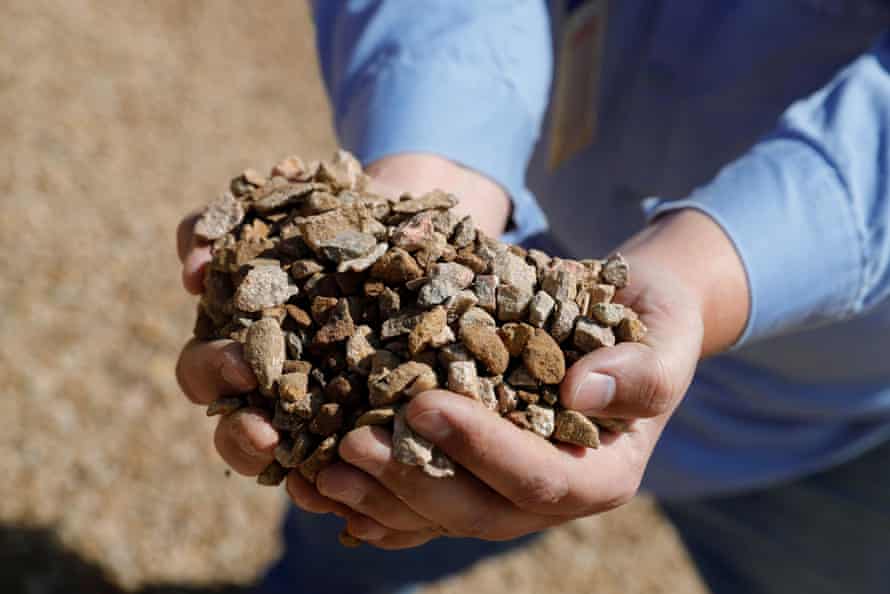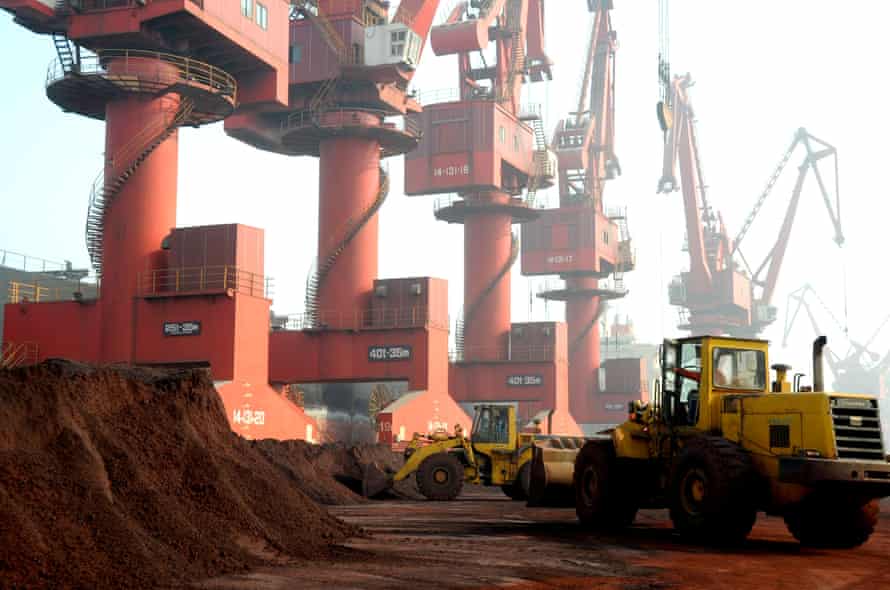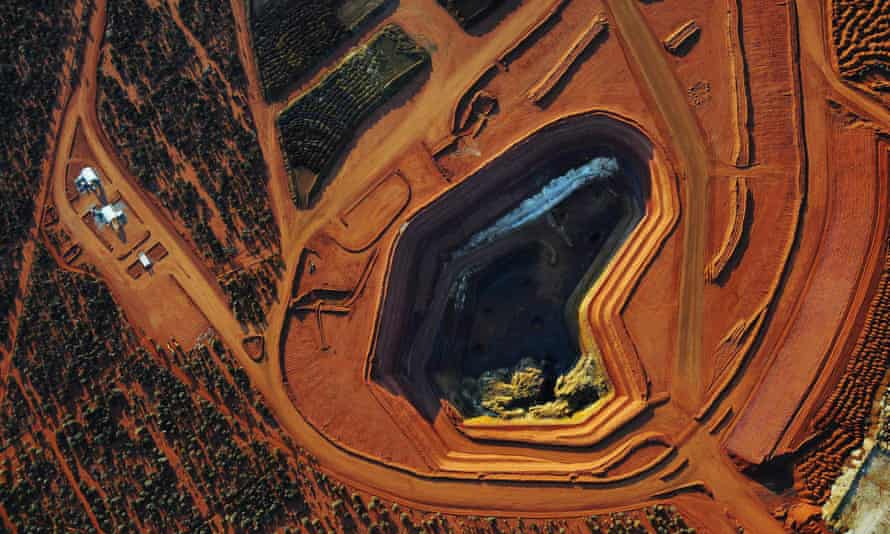The Global Race for Rare Earths
"I don't think the average person realizes how deeply rare earths have seeped into the fabric of daily life. They're all around us. ""Biden is making a big push to set up some alternative suppliers. Nothing's happening anytime soon, but I think within five years or so we could see the beginnings of tangible alternatives.""Having that mine production [in California] in the U.S. is a great first step because it helps solve the chicken and the egg issue."Ryan Castilloux, analyst, Adamas Intelligence research firm, Ontario
 |
| Rare earth ore from a mine in California. The metals are difficult to refine and costly to extract. Photograph: Steve Marcus/Reuters |
"Who would invest in a rare earth mine with no access to a downstream facility [for processing] to create value-added rare earth products?""Who would invest in a value-added manufacturing facility when there is no upstream mine to source from?"Pierre Gratton, chief executive, Mining Association of Canada"The world is undergoing an economic transformation, with innovative technologies, clean technologies, driving the pace of change.""This is not going to be easy. But there's growing confidence that it can be done.""The risk of not doing it is that there also goes the technology -- the high-tech jobs and high-tech schools and programs."Ian London, executive director, Canadian Critical Minerals and Materials Reliance
 |
| Soil containing rare earth elements at a port in Lianyungang. China is by far the world’s largest producer of the minerals. Photograph: China Stringer Network/Reuters |
The world, in a very real sense, is in competition with China to access and preserve a fair share of rare earths minerals, critical to modern technology. Rare earths elements represents a group of 17 materials that are becoming increasingly vital to modern technology in their use in electric vehicles, solar panels, wind turbines, military defence programs (missile guidance systems), headphones, motors and a wide range of other advanced technologies. The world is awakening to their critical function to the economy and security of the future.
Adamas Intelligence forecasts global demand for rare earths is set to increase at an annual growth rate of 7 percent until 2030. Rare earths are used for a type of magnet accounting for 90 percent of the elements' value, predicted to grow at ten percent through 2030, from 62,000 tonnes at present to 148,000 tonnes annually by 2030. Increasing demand for electric vehicle traction motors and other e-mobility applications such as electric bicycles, scooters and mopeds represent 77 percent of that growth.
 |
A wheel loader operator
fills a truck with ore at the MP Materials rare earth mine in Mountain
Pass, California, January 30, 2020. Steve Marcus | Reuters |
Rare earths magnets are so critical to electric vehicles, according to analysts due to the fact that they represent a lighter weight alternative to conventional motors, promising to extend a vehicle's range for electric vehicles. Neither the United States nor Canada has established a supply chain of rare earths, even while China controls 70 percent of rare earths supply. A shaky situation given that China controls 90 percent of complex processing needed to transform rare earths into magnets and powders as end products.
'Rare' they may be identified as, but North America has great potential in rare earths where Canada has an estimated 830,000 tonnes of rare earths reserves, and nearly every province has seen identification with potential deposits that could be mined. Canada and the U.S. finalized a joint action plan on critical minerals in 2020, including rare earths, requiring increased cooperation on developing supply chains, research and development, along with support for the industry.
 |
| REE Periodic Table: The Rare Earth Elements are the 15 lanthanide series elements, plus yttrium. Scandium is found in most rare earth element deposits and is sometimes classified as a rare earth element. Image by Geology.com. |
And it is a complex industry in total, requiring in-depth processing to begin with by taking rare earths out of the ground, separating, refining and placing them into products. First, the ore must be extracted from the ground, then the rare earths are to e separated from other elements, a complex process requiring manipulating radioactive material. Following that, the rare earths must be separated from each other, and finally the processing of individual rare earths into oxides to be further processed into powders.
 |
| Uses of rare earth elements: This chart shows the use of rare earth elements in the United States during 2020. Many vehicles use rare earth catalysts in their exhaust systems for air pollution control. A large number of alloys are made more durable by the addition of rare earth metals. Glass, granite, marble, and gemstones are often polished with cerium oxide powder. Many motors and generators contain magnets made with rare earth elements. Phosphors used in digital displays, monitors, and televisions are created with rare earth oxides. Most computer, cell phone, and electric vehicle batteries are made with rare earth metals. |
Finishing stages where the intermediate products are then converted into magnets or motors and inserted into products, complete the long and complex transitions. One of the largest rare earths mines in the world is in operation in California close to the border with Nevada, and it has been supplying its ores to China. A situation soon to change as a processing facility is being built in the United States. In the Northwest Territories, some 100 kilometres east of Yellowknife Cheetah Resources Corp an Indigenous enterprise, plans to mine small portions of rare earths from its Nechalacho project.
The ensuing product is envisioned as travelling by barge to Hay River and from there to Saskatchewan, then heading to Norway for further processing. The biggest rare earths company, Neo Performance Materials Inc. has no operations in Canada, doesn't mine, but is headquartered in Toronto, with a growing business enterprise geared to producing magnets with facilities in Estonia, Thailand and China.
China was able to create millions of jobs while increasing its capacity to manufacture various products, from refrigerators o washing machines, all occurring through its gaining of control of the rare earth supply chain. The country dominates the market in producing all manner of goods in its long grasp for production primacy, the globe its trading partner.
 |
| Stockpiles of rare earth ore at the Mount Weld mine in Western Australia. Photograph: Lynas Corporation/AFP/Getty Images |
Labels: Advanced Technology, China, Production, Rare Earths Elements

0 Comments:
Post a Comment
<< Home